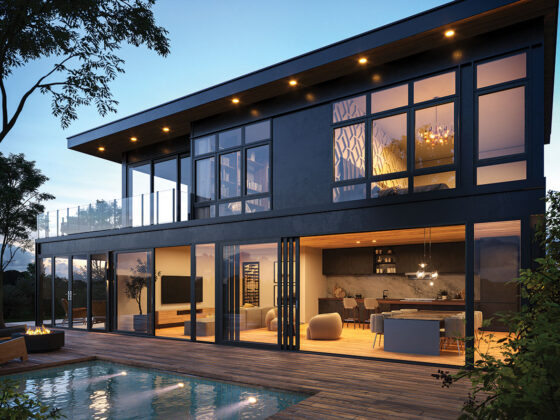
Home tech options continue to grow.
Story by Tracy Dickinson
Featured in September/October 2022
Most Americans have a love-hate relationship with technology. But we can’t deny that our daily lives are forever entwined with it, from the phones we carry in our pockets to the way even our language has changed (“e-everything,” “dot com,” and more).
Some applications may not seem like improvements. Consider gas pumps that play ads while you pump gas. But rapidly developing technology continues to transform the way we live our lives. And it’s transforming the way our homes function, too.
Even if you don’t have a smart home (“smart” stands for self-monitoring analysis and reporting technology), the products available are getting smarter every day, and there’s something for every area of your home.
S – Security
Home security systems have been around for decades, typically through a contract with a security service. These days, even home security can be integrated and controlled with the rest of your home’s technology.
Doorbell security cameras are a popular security option. Eric Carpenter, Audio/Video/Data Comm Manager for Kline Electric, says the cameras can be ideal for most homeowners. “We offer and install a number of IP Camera Systems, including RING products,” he says. “We run cable from each camera to the main network recorder, which can be accessed with a mobile app as well as from the home network.”
In addition to convenience, these systems require no recurring fees or contracts with an outside service.
M – Maintenance
Technology, even in its oldest forms, has always served to ease the workload, from the invention of the washer and dryer to today’s high-tech appliances. Remote control and robotic vacuums have outpaced the in-home vacuum systems and don’t require major construction.
Even lighting options have advanced to the point where maintenance is almost nonexistent. “LED light fixtures are really the norm in new construction and remodels,” Carpenter says. “But it’s a simple upgrade from incandescent to LED for minimal cost. It really just requires changing out the switches. And you’ll likely never have to change a bulb as long as you own your home.”
A – Automation
Home automation, a feature that used to be limited to only high-end executive homes is more and more common in today’s new homes. “At Kline, we have a 10-member team of electricians that specialize in tech installations,” says Carpenter. “My team is fully focused on tech. That’s all we do.”
The home automation system that Kline uses, Control4, allows the homeowner to control everything from electronic devices to the temperature of the home. In new construction, it’s become the norm to install fiber lines directly to the property so that the wiring needed is already in the ground.
“At Kline, we have a 10-member team of electricians that specialize in tech installations,” says Carpenter. “My team is fully focused on tech. That’s all we do.”
Eric Carpenter, Kline Electric
Carpenter says, “The Control4 system connects all your devices and systems so you can access everything from one app. You could control each of your devices from your phone without a whole-house system, but each one has to be controlled separately. And inside the home, you just need one touchscreen panel to manage everything.”
Although the upfront cost is higher, Carpenter says Kline’s clients find the advantages and the cost savings with automating utilities far outweigh the initial expense. “A whole-house system also allows you to program devices and set automated schedules. That means you can adjust the temperature and lights even when you’re not home. You can touch one button to dim the lights, lower the shades, turn on the television, and adjust the sound system for movie night,” he says. “The ability to have all those devices on set schedules can save you time and money in the long run.”
R – Remote Control
Whether you have a whole-house control system or not, most manufacturers offer product lines that can be controlled remotely. Window coverings, appliances, entertainment—all can be adjusted from across the room or across the world. Many can also be set to voice control if you have a device like Alexa, Siri, or Google Assistant.
“Nearly every home uses some sort of streaming service for television and audio,” Carpenter says. “All it takes to run those services and your remote device control is internet or Wi-Fi. But if you’re relying on just the wireless network for all your streaming, gaming, cell phones, tablets, etc., you’re going to see your Wi-Fi speeds drop significantly.”
Because of this, Carpenter advises his clients to opt for ethernet lines directly to their televisions and wireless access points (WAP) throughout the home for consistent wireless coverage. “Having an ethernet line to each smart television location allows direct internet connection and the fastest speed possible for downloading streaming content,” he explains. “And the WAP uses an ethernet cable directly to the modem or router so that you can adjust Wi-Fi output to ensure coverage both inside and outside the home.”
T – Trends
Wi-Fi accessibility outside the home is one of the trends Carpenter has seen on the rise in the past year or so. “A lot of our clients are looking for outdoor or landscape audio systems as they’re using their backyards to extend their living space,” he says.
“Typically, we just need a means of wiring the outdoor speakers, so we do recommend installing them in existing landscaping.” Although the outdoor systems are designed to weather the elements, tucking them into landscaping protects them from foot traffic and lawn maintenance damage.
Another hot trend is the picture frame television, currently only available from Samsung. “The Frame TV by Samsung is one of the most requested options,” Carpenter says. “It uses a stand-alone box for all the connections (HDMI, coaxial, ethernet, etc.), with a One Connect fiber optic cable between the box and The Frame TV, which comes preloaded with hundreds of artwork reproductions.”
When the television is not in use, the design resembles a picture frame. The homeowner can set the system to display one of the stored images or one of their own, making the television appear to be a framed painting.
“The product is offered in several sizes, up to 85 inches, with different bezel frame designs to suit your decor,” says Carpenter. “You can also get it in three different colors.”
With the constant changes in product technology, choosing the smartest options to make your home a smart home can be intimidating. But if the purpose of technology is to make our lives more convenient, integrating those products might be the smartest choice of all. •
Resources
- Eric Carpenter, Kline Electric








